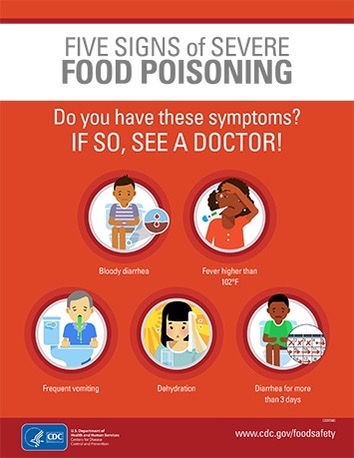Food Poisoning Symptoms
Food poisoning symptoms can be anywhere from mild to very serious. Your symptoms may be different depending on the germ you swallowed. The most common symptoms of food poisoning are:
- Upset stomach
- Stomach cramps
- Nausea
- Vomiting
- Diarrhea
- Fever
After you swallow an unsafe (contaminated) food or drink, it may take hours or days to develop symptoms. If you have symptoms of food poisoning, such as diarrhea or vomiting, drink plenty of fluids to prevent dehydration (not having enough water in your body).
When to See a Doctor for Food Poisoning
See your doctor or healthcare provider if you have symptoms that are severe, including:
- Bloody diarrhea
- High fever (temperature over 102°F, measured in your mouth)
- Frequent vomiting that prevents keeping liquids down (which can lead to dehydration)
- Signs of dehydration, including little or no urination, a very dry mouth and throat, or feeling dizzy when standing up
- Diarrhea that lasts more than 3 days
Serious Health Problems and Long-Term Effects From Food Poisoning
Most people have only mild illnesses, lasting a few hours to several days. However, some people need to be hospitalized, and some illnesses cause long-term health problems or even death. Infections spread by food can lead to:
- Chronic arthritis
- Brain and nerve damage
- Kidney failure caused by hemolytic uremic syndrome (HUS)
Symptoms and Sources of Common Food Poisoning Germs
Some germs make you sick within a few hours after you swallow them. Others may take a few days to make you sick. This list provides the symptoms, when symptoms begin, and common food sources for germs that cause food poisoning. The germs are listed in order of how quickly symptoms begin.
- Symptoms begin 30 minutes to 8 hours after exposure: Nausea, vomiting, stomach cramps. Most people also have diarrhea. Common food sources: Foods that are not cooked after handling, such as sliced meats, puddings, pastries, and sandwiches
- Symptoms begin 2 to 48 hours after exposure: Watery diarrhea, nausea, stomach cramps, vomiting, fever, chills Common food sources: Raw or undercooked shellfish, particularly oysters
- Symptoms begin 6 to 24 hours after exposure: Diarrhea, stomach cramps. Usually begins suddenly and lasts for less than 24 hours. Vomiting and fever are not common. Common food sources: Beef or poultry, especially large roasts; gravies; dried or precooked foods
- Symptoms begin 6 hours to 6 days after exposure: Diarrhea, fever, stomach cramps, vomiting Common food sources: Raw or undercooked chicken, turkey, and meat; eggs; unpasteurized (raw) milk and juice; raw fruits and vegetables
- Other sources: Many animals, including backyard poultry, reptiles and amphibians, and rodents (pocket pets)
- Symptoms begin 12 to 48 hours after exposure: Diarrhea, nausea/stomach pain, vomiting Common food sources: Leafy greens, fresh fruits, shellfish (such as oysters), or unsafe water
- Other sources: Infected person; touching surfaces that have the virus on them
Clostridium botulinum (Botulism)
- Symptoms begin 18 to 36 hours after exposure: Double or blurred vision, drooping eyelids, slurred speech. Difficulty swallowing and breathing, dry mouth. Muscle weakness and paralysis. Symptoms start in the head and move down as the illness gets worse. Common food sources: Improperly canned or fermented foods, usually homemade. Prison-made illicit alcohol (pruno).
- Symptoms begin 2 to 5 days after exposure: Diarrhea (often bloody), stomach cramps/pain, fever Common food sources: Raw or undercooked poultry, raw (unpasteurized) milk, and contaminated water
- Symptoms begin 3 to 4 days after exposure: Severe stomach cramps, diarrhea (often bloody), and vomiting. Around 5–10% of people diagnosed with E. coli develop a life-threatening health problem. Common food sources: Raw or undercooked ground beef, raw (unpasteurized) milk and juice, raw vegetables (such as lettuce), raw sprouts, unsafe water
- Symptoms begin 1 week after exposure: Watery diarrhea, loss of appetite, and weight loss. Stomach cramps/pain, bloating, increased gas, nausea, and fatigue. Common food sources: Raw fruits or vegetables and herbs
- Symptoms begin 1 to 4 weeks after exposure: Pregnant women usually have a fever and other flu-like symptoms, such as fatigue and muscle aches. Infections during pregnancy can lead to serious illness or even death in newborns.
- Other people (most often older adults): headache, stiff neck, confusion, loss of balance, and convulsions in addition to fever and muscle aches. Common food sources: Queso fresco and other soft cheeses, raw sprouts, melons, hot dogs, pâtés, deli meats, smoked seafood, and raw (unpasteurized) milk

